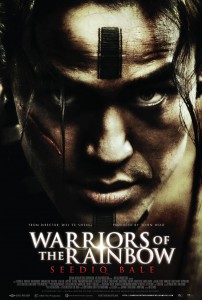Director: Wei Te-Sheng
Cast: Umin Boya, Masanobu Ando, Landy Wen, Irene Luo, Vivian Hsu, Chi-Wei Cheng, Lin Ching-Tai, Da-Ching
Running Time: 144 min. (Part 1)
Running Time: 132 min. (Part 2)
Running Time: 150 min. (single version)
By HKFanatic
“Warriors of the Rainbow: Seediq Bale” arrives from director Te Sheng-Wei and producer John Woo. The film is officially the most expensive Taiwanese production of all time and has been released overseas in both an International Cut that runs 4 and 1/2 hours long, and an abridged version that clocks in at 154 minutes.
For the purposes of our review, Cityonfire.com was provided with the abridged cut but distributor Well Go USA is making the International Cut available to US audiences on both Blu-ray and DVD. Due to its edited nature, the shortened cut can at times feel chaotic, which is not helped by the film’s choppy editing and general lack of establishing shots. Die-hard film buffs will likely want to hold out for the International Cut in order to get the full story.
“Seediq Bale” dramatizes the events of the Wushe Incident of 1930, which was the last major uprising against Japanese colonial forces in Taiwan. The film follows several aborigines tribes living in the mountains of central Taiwan during the time the Japanese invaded and took over. The Seediqs aren’t exactly presented as a peaceful, nature-loving people – in fact, they view the beheading of one’s enemies as a means to ensure passage into the afterlife – but, after initial skirmishes, they manage to co-exist with the Japanese colonists for about 25 years.
After this time, the continued Japanese occupation threatens to destroy the Seediq’s hunting grounds and their way of life via rampant deforestation. Thus, the various Seediq clans prepare for a bold attack against their oppressors. The viewer gets the impression that this last ditch assault is also meant to ensure the honor of the younger Seediq members since they have not yet been tested in battle.
The Japanese have spent the last decade being demonized in many Asian films due to their war-mongering past, and “Warriors of the Rainbow” continues the trend of portraying the Japanese as cartoon-like bad guys (with only a few exceptions). That said, it will likely be difficult for most viewers to identify with the Seediq tribe since they engage in the wanton slaughter of women and children as well.
There are no black and white heroes here, with carnage and slaughter on both sides of the conflict. The film ultimately makes humanity seem like a futile effort. While many viewers may find the moral murkiness a refreshing change of pace – and true to history – I must admit the violence became somewhat numbing after 150 minutes of almost nonstop beheadings and mass suicides.
The filmmakers earn points for being historically accurate on several accounts, such as the Japanese’s controversial decision to use gas bombs (breaking a then-current Treaty). But while it trades in many of the same stylistic motifs as movies like “Last of the Mohicans” and “Apocalyptico” – copious slow motion for moments of bloodshed and high drama – it fails to give viewers a character to identify with. Altogether, “Seediq Bale” is a handsomely mounted but depressing affair, confirming all over again that the 20th Century’s legacy was written in blood.
HKFanatic’s Rating: 6/10



